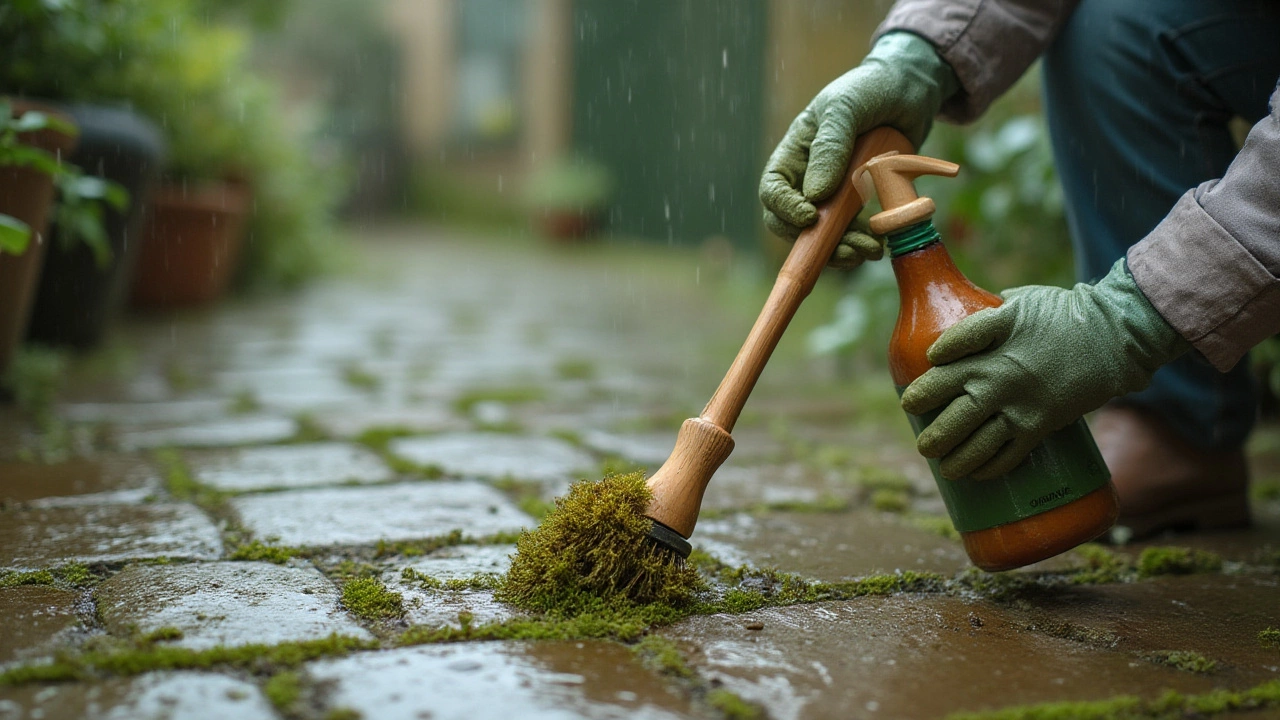You ever glance at your shabby patio and think, “How the hell did it get this grimy?” You spend an afternoon scrubbing, breathing in sharp cleaning fumes, only to find the moss and mildew slip back after the first drizzle. But here’s something nobody tells you – a squeaky-clean patio shouldn’t come at the cost of your garden’s health, the neighbour’s dog, or the bees doing laps in your borders. Most outdoor cleaners on the UK market promise sparkling stone but don’t talk much about where those suds end up. Spoiler: it’s your grass, your drain, and straight into rivers. If you care about what your family and pets walk on, it pays to take a proper look at what goes into your cleaner. Ready to get stubborn stains off your slabs and feel good about it?
How Mainstream Outdoor Cleaners Wreck More Than Grime
Stroll down any big store’s cleaning aisle and you’re greeted by walls of bottles with extra-bright labels: “Kills 99.9% of everything”, “Maximum power”, “Ultra bleach”. For years, these were the obvious pick. Get the job done, fast. Except, most mainstream outdoor cleaners pack a cocktail of things you wouldn’t want near your veg patch. Chlorine bleach, ammonium compounds, sodium hypochlorite – they smash stains, but also zap worms and insects, damage grass edges, and leak into watercourses during the next rain. Ever noticed weeds dying at the patio’s edge after a big clean? That’s not a coincidence.
A study by the UK Environment Agency in 2023 revealed sodium hypochlorite residues were found in 14% of tested river sites – and that stuff can make aquatic life seriously ill. What seems powerful and practical on Saturday afternoon turns into years of ecosystem cleanup. The air isn’t any better inside your own garden. The fumes from harsh cleaners can trigger asthma or headaches when the wind shifts, and they linger where kids play or where pets roll.
Plus, mainstream formulas are usually tested in labs, not on your mucky Bristol patio layered with genuine British slime. They may leave surface residues, which make paving slippery once it rains. What’s more, they strip out the tiny organisms that grip onto your stones and keep green growth at bay. Result? You clean, but the mess comes back quicker and sticks harder. It’s a lose-lose for anyone craving both clean slabs and a healthy, thriving garden.
Ever hit a patch of killer moss where your cleaner spilled and noticed only that bit of lawn dies? That's chemical runoff. Worried about your cat walking damp floors to lick its paws? That’s real, too. For those wanting more than a flash-in-the-pan clean, it’s time to check what’s actually inside that bottle. Next up: the science behind what makes a genuinely green cleaner.
What Makes a Cleaner Truly Eco-Friendly?
Loads of brands toss the word ‘eco’ about, but let’s strip the greenwashing. An outdoor cleaner earns the eco label if it breaks down fast in the environment, doesn’t persist in waterways, and isn’t toxic to pets, wildlife, or plants. Natural doesn’t always mean better, though; citrus oils sound great, but some can stain stone or cause respiratory reactions in dogs. The real gems are cleaners certified by proper third parties—think EU Ecolabel or the Vegan Society—not just the word ‘eco’ printed in leafy font.
The magic ingredients? Usually, plant-based surfactants, soft organic acids (like citric acid), and sometimes enzymes that munch through stains without messing up the food chain. You’ll never find bleach, ammonia, or phosphates in these formulas. Read the label, and if you see long words you can’t pronounce or hazard warnings, put it back. Look instead for things like “biodegradable”, “greywater safe”, or “pet safe after drying”. They usually wash away into nothing overtime and don’t hang around poisoning anything downstream.
An interesting twist: studies from Bristol University in 2022 showed some common eco patio cleaners were actually as effective at shifting algae and black spot as the nuclear options – but took 10 to 15 minutes more. Patience, then, is the real cost. Another thing to be wary of: vinegar is often recommended in online forums, but on UK stone, it can etch and dull surfaces and harm planting beds with repeated use. Citric acid is gentler and breaks down just as well. And sometimes just water, elbow grease, and a stiff broom do most of the work, with an eco-cleaner as the finisher to get deep into the cracks.
Let’s not forget, if it releases lots of foam, that’s often a red flag. Real green cleaners give little or no bubbles – because they’re designed to do all the heavy lifting where they land, not impress you with a suds show. Check below for a quick fact table comparing ingredients and effectiveness in the UK:
| Cleaner Type | Main Components | Breakdown Time | Pet Safe | Effectiveness |
|---|---|---|---|---|
| Bleach-based | Sodium Hypochlorite | Months | No | High (but toxic) |
| Vinegar DIY | Acetic Acid | Weeks | Varies | Medium (may harm stone) |
| Eco-Enzyme | Plant enzymes | Days | Yes | Medium-High |
| Citric Acid | Lemon-derived acid | Days | Yes | High (safe for most stone) |
| Commercial Eco (UK) | Plant surfactants, minerals | Days | Yes | High |
Bottom line? The best eco outdoor cleaners are built to tackle grime, then vanish—with no legacy for your hydrangeas, your hens, or the hedgehogs. So, which brands actually live up to that?

Top Brands and DIY Alternatives That Actually Work
Let’s cut through the hype. In the UK, certain brands actually stand out for both cleaning grunt and green credentials. Among the lot, eco-friendly outdoor cleaner solutions from companies like ECOS, Bio-D, and Delphis Eco come up trumps. Bio-D’s Patio Cleaner, for example, leans on naturally fermented plant acids and is certified cruelty-free. Households report black spot shifting after one soaking, with no dead patches or pet problems.
Delphis Eco Patio & Stone Cleaner, often used by pro gardeners, is another favourite. It blitzes algae without torching your borders and is fully biodegradable. Their big claim: you can literally return the runoff to your garden beds thanks to a neutral pH and no nasties. For smaller, everyday stains—bird droppings or that weird black lichen—ECOS Outdoor Cleaner works using coconut-derived surfactants. Even the bottles are made from recycled plastic, which cuts down waste beyond the formula itself.
Then there’s the DIY crowd. Make your own with water, citric acid, and a drop of gentle washing-up liquid. Add 3 tablespoons of citric acid (available at most hardware shops) to 2 litres of hot water, mix with a splash of eco washing-up liquid, scrub in, leave it for 15–30 minutes, and rinse well. This homebrew kills moss, lifts mildew, and breaks up slime with zero run-off fear. Some also spike it with a teaspoon of bicarb for extra fizz, but don’t overdo it—too much will leave a residue.
Here’s a quick ‘How-To’ for an eco-friendly clean-up:
- Sweep up all loose leaves, twigs, and surface dirt. Don’t skip this step or you’ll just smear the muck around.
- Mix up your eco-cleaner of choice (bought or DIY) in a watering can for even pour.
- Douse the target areas well, then agitate with a stiff, natural-bristle brush—nylon brushes can sometimes scratch softer stone.
- Let it sit for at least 20 minutes (the old alternates needed time, but so do modern eco options).
- Scrub concentrated marks and then rinse off with a bucket or hose, aiming runoff onto grass or garden, not into a storm drain.
- If you’ve got a high water table (common in Bristol), use minimal cleaner and rinse carefully to avoid flooding your beds with too much water or product.
Another pro-tip: try cleaning when it’s dry, but the forecast threatens rain a few hours later. Nature gives you a free rinse, and you save water. Check out forums like the RHS for reviews—Brit gardeners are not shy about sharing what bombed or rocked in their own patches. One thing’s for sure, if a cleaner works for a mossy, rain-lashed patio up north, it’ll handle whatever’s growing on yours in Bristol, Bath, or beyond.
Tips to Keep Your Outdoor Spaces Green and Grime-Free Next Season
You’ve cleaned up the mess. How do you stop it making a comeback? Start by keeping shade-loving grime under control. Prune overhanging branches and make sure your patio sees as much sunlight as possible—sunlight zaps algae before it gets a foothold. Sweeping regularly keeps leaves and seeds from rotting into dirt—once you get into the habit, it only takes five minutes a week, and prevents a big annual deep clean.
Resist the urge to overuse any cleaner, commercial or homemade. Even with natural ingredients, too much can disrupt the micro-ecosystem living on your stone and in your soil. Spot-clean stains as you notice them, and save the big scrub for spring or autumn. If moss is your main headache, use sand or fine gravel between stones—moss hates dry spots and struggles to anchor itself.
Consider a rainwater collection setup—not only are you reusing what falls free from the sky, but it’s softer than tap water and doesn’t leave limescale streaks after rinsing. If you’re sharing the patio with pets or kids, always double-rinse, just in case small paws go borrowing for snacks after you finish. And leave a bit of wildness at the edges. Butterflies and solitary bees love a few untouched, mossy tufts between pavers, and they repay you by pollinating the garden come spring.
Lastly, if you want your cleaning routine to last, avoid heavy jet-washing. It’s tempting, but pressure washers gouge cement and force dirt deep into cracks, making grime harder to shift next time. Stick to manual scrubbing and eco cleaners, and you’ll barely notice the effort by the end of summer. Nature, your lawnmower, and next-door’s curious cat will thank you for it. As habits bed in, your patio will stay cleaner, your garden greener, and you can feel good about every barbecue, picnic, and mug of tea you have out there—even if you drop a sausage or two on the flags now and then.
